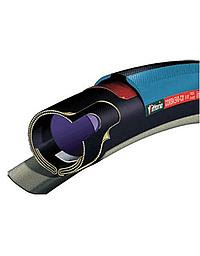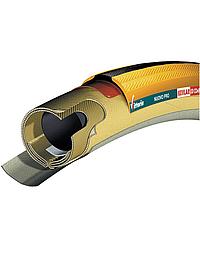Tubulars: Part I
 Fri, July 27, 2007
Fri, July 27, 2007 
A regular reader of this blog recently asked me if I would write a piece comparing tubular tires to clinchers.
My first reaction was that I am not qualified to do so because since I started riding seriously and racing in 1952 to this day, I have ridden tubulars exclusively.
How can I comment on the ride quality of a modern clincher tire when I have never ridden on them? I contacted a good friend Steve Farner, who lives in Southern California, for a second opinion. Steve has ridden and raced in the 1970s through the 1980s. In an email he wrote:
"I've noticed pro teams in the Tour that are using tubulars, even if they are sponsored by clincher tire companies, discreetly glued to tubular rims with other makers' names affixed. Seems many pros will use tubulars (even not admitting they do); I think they prefer the feel and ride compared to clinchers, in spite of manufacturers' claims they are the same now. I also use tubulars and will never ride clinchers; they don't compare. It is easier to manufacture clinchers and that is a big reason for the push to race clinchers, not at all because they are better. Thus the deception racing on tubulars instead of clinchers."
Steve makes a valid point about the cost of manufacture. I ride on Vittoria Evo Corsa CX tires; they cost me $47. (See top picture.) This is a top of the line tubular and they can go for twice that amount. I shop around.  From the same source, I could buy a Vittoria Diamante Pro clincher tire for $31.57. (Left.) Add the cost of the inner tube, (Included in the tubular price.) and the price is close. The big difference is the tubular tire is hand made, and the clincher I’m sure is manufactured by an automated process. There is bound to be more profit in the clincher tire.
From the same source, I could buy a Vittoria Diamante Pro clincher tire for $31.57. (Left.) Add the cost of the inner tube, (Included in the tubular price.) and the price is close. The big difference is the tubular tire is hand made, and the clincher I’m sure is manufactured by an automated process. There is bound to be more profit in the clincher tire.
Manufactures will tell you the ride quality and performance of the latest clinchers are the same as a tubular; they push the product that turns the most profit. Many tire companies don’t even make tubulars, so obviously they are not going to say their tire is inferior to another manufacturer’s product.
If pros and top amateurs still race on tubulars it is because the ride quality and the more important, the performance is superior. That is the way I see it, because pro riders will normally ride whatever they are paid to ride; all other things being equal.
If you are not racing, and not looking for a competitive edge, does it really matter? Of course not; a person rides clinchers for convenience; it is easier to fix a flat. (Puncture.)
Having said that, if I get a flat, I do like the convenience of being able to slip a spare tubular on the rim, without the use of tools, inflate it, and be on my way. A spare tubular folds up and fits neatly under my saddle, along with a CO2 inflator. In an absolute emergency, I can ride home on a tubular tire while it is flat, without damaging the rim.
They are lightweight, some can be inflated up to 130 psi so there is very little rolling resistance. At the same time because they are a complete tube, they absorb the shocks of riding over very rough road surfaces. They are extremely responsive and this is why they are preferred for racing, you make a sudden effort and the wheels and tires respond immediately.
The biggest factor in deciding whether to use tubulars is the cost. Not that they cost a lot more initially, but you have to consider the possibility of buying a new tire every time you get a flat. Some people don’t know how to repair a tubular tire, others can’t be bothered.  In my case, I ride purely for pleasure these days, so I ride tubulars because they give me pleasure in the way they ride. To me the cost is justified.
In my case, I ride purely for pleasure these days, so I ride tubulars because they give me pleasure in the way they ride. To me the cost is justified.
However, in researching for this piece, I discovered I can buy a lower price Vittoria Nuovo Pro TT tubular, still considered a racing tire for $22.78. (Left.) Alternatively, I can buy a Vittoria Rally training tubular for $15.77.
It is somewhat extravagant for me to be using one of the best tubulars available, when I am no longer racing. At these prices, it is less important to spend time repairing them.
I should buy a few spare, because if a person can afford to do this, and they are stored in a cool dark place, like a closet; the rubber matures and becomes tougher with age; they wear longer and resist punctures.
If you have never ridden tubulars and are considering this, you will not be disappointed.
However, look on it as a possible high maintenance relationship. In such relationships you are let down flat a few times, and you wonder if it is worth it. Stick with it for the long term and you will find it is.
Footnote: Tubular tires are often refered to as "Sew-ups" or "Tubies" in the US, and as "Tubs" in the UK.
Pictures from Pro Bike Kit.
In part 2 I talk about repairing tubulars, and part 3, gluing the tire to the rim.
 Dave Moulton | Comments Off |
Dave Moulton | Comments Off |  Bike Tech
Bike Tech 

















Reader Comments (20)
I use to spend the time to fix my tubular flats back in the 70s but was convinced to switch to clinchers. Buying expensive new tubs just wasn't in the budget.
Clinchers are easy and quick to fix on the road but your suggestions and the reasonableness of the pricing will surely get be back on tubulars. I look forward to check their ride quality.
Size issues? I've noticed a strong trend by riders to get larger tires (28mm and higher) as few are serious racers. Clues on where you shop?
And yes it's all about the pleasure...
Thanks again!
Jack
(My suspicion is that tubulars will be the next big thing, starting with the fixed/hipster crowd.)
I've never used sewups because I've never really been clear on what you do when you get a flat. Can you just pull it off, put on a new tubular, and repair it later? What about the glue? Will an inflated tubular tire stay on without glue?
I'm definitely considering them for my winter training bike. They seem to go, used, for a bit less on ebay, possibly because others are similarly uninformed as myself.
Good post, thanks. Excellent information here at this site as a scientific look at tubies.
http://www.engr.ku.edu/~kuktl/bicycle/bicycle.html
I tried the tubular clinchers
but never tubulars
I am a mountain biker
I need to get with the modern version; tubeless
You and Terry sounds almost the same.
I love tubular but wish, wish they make something bigger. Like 25c will be nice. In that case, I will ride it everywhere.
It's pretty impressive on wet roads, dirt and broken pavement. And they ride good enough to keep them on as your daily wheels.
I ride and race clinchers now more for reasons of budget (and time) rather than "feel". No doubt about it, a tubular is a superior ride. Bike handling is greatly improved.
1. there was a reason they were selling them off so cheap
2. the money I saved on the rims was more than made up for by all the tires I was now purchasing and I was too f'n lazy to repair them--I've got a whole box of old tubs lying in my parents basement, because one day, yes, one day I'm going to repair them. Right.
Not content to learn my lesson, while studying in Europe, I bought an old French club bike equiped with tin-foil Mavic sprint rims--if you just looked at those things funny they would dent. Again, it was cheap--70 Euro. Since much of my riding was through the city center, the tires would be full of cuts after less than a week. Then it would be a matter of trolling all the bike shops trying to find tubulars for less than 25 Euros, because I was STILL too f'n lazy to patch the flippin' things.
If you've got more money and time than brains, then sure, go for tubulars. Otherwise, I would stick with clinchers--in any case it's been shown that they roll better at higher pressures because the tubular glue generates a constant hysteresis loss.
ariesboy@comcast.net
Flats!!!
Just pump them with Stans or tufos very own version of slime and you are set to go. I have light panaracers or tufos that I carry on my kit bag. But the stans or tufos liguid have saved the day. And you can replace a tubular faster than a clicher especially if you get the double sided tape from tufo.
The ride -- yes that's the reason. For the track --- there is no reason for clinchers at all!
I would like to add my endorsement to the use of tubulars, or "singles" as they are called in Australia. I used to get by because most good bike shops would have access to a retired person who would pick them up andrepair them for a ten dollars or so. Where I lived was in an entertainment district and I would get a puncture every 10 days on average from the tiny slivers of glass, both green and brown.
I too have used both tires You need to compare apples to apples meaning buying the best of both well at least same price.
The clincher tires I went with Michelin Pro 2s and the tubulars I went with Conti Sprinters
To sum this up quick I will say the Sprinters do roll up faster but the Pro2 tires do feel similar for most of the other comparisons.
The tubulars are more supple and corner better in wet conditions.
Tubular rims are lighter and going up mountains I need lighter so I sticking with Tubulars.
I used to ride with tubuars and what I could remember was that they felt like I was riding with suspension. I still have my wheels and will eventually go back to them, when I get my old Motobecane back on the road. Ciao
I don't see any mention of the decreased frequency of pinch flats with tubulars. I think that is perhaps the most significant advantage of using sew-ups on my racing wheels.
When I was young I used silk tubular especially for race. They were very very expensive but the difference between silk tubulars and clinchers is the same between a Lamborghini and a city car!
Mario